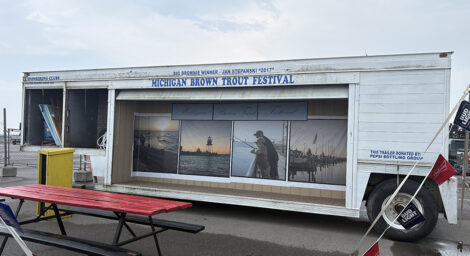Research team uses robots to search for shipwrecks

News Photo by Darby Hinkley From left to right are researchers Corina Varvalada of Louisiana State University in the Department of Mechanical and Industrial Engineering, Katie Skinner, assistant professor at the University of Michigan in the Robotics Institute and the Department of Naval Architecture and Marinee Engineering, Guy Meadows, founding director of Great Lakes Research Center at Michigan Technological University, and Jamey Anderson, assistant director of Great Lakes Research Center at Michigan Technological University. They are posing with IVER AUV.
ALPENA – Autonomous underwater vehicles can do a lot of things for research, including search the bottom of Thunder Bay National Marine Sanctuary for shipwrecks.
Researchers from the University of Michigan, Michigan Technological University, and Louisiana State University were in Alpena last week using these underwater robots to obtain pictures of existing shipwrecks, and hoping to find more of the same.
Thunder Bay National Marine Sanctuary is home to nearly 100 known shipwrecks, with an estimated 100 more waiting to be found.
“We have a NOAA-funded project here to go out into Thunder Bay National Marine Sanctuary with our autonomous underwater vehicles,” said Katie Skinner, assistant professor at the University of Michigan in the Robotics Institute and the Department of Naval Architecture and Marine Engineering. “The main goal of the project is to develop methods to automatically process the data that we bring back from those vehicles, so that we can faster detect shipwrecks or any unknown archaeological sites in the bay.”
NOAA stands for the National Oceanic and Atmospheric Administration.

Courtesy Photo Above, Mason Pesson, master’s student at Louisiana State University, launches an autonomous underwater vehicle into Thunder Bay. These AUVs provide valuable research data for learning about shipwrecks and archaeological sites.
“The goal is to increase the efficiency of processing the data that we can collect autonomously, and that would then decrease the cost of deploying these vehicles,” Skinner explained. “Right now we have to go out on the boat and sit and still watch what they’re doing, to some degree. So, we want to work towards being able to just send them out into the water, and see what they come back with.”
Two vehicles were being used in last week’s research – Michigan Tech’s IVER AUV, and Dory and Nemo.
“We have two remotely-operated vehicles, Dory and Nemo,” said Corina Barbalata of Louisiana State University in the Department of Mechanical and Industrial Engineering. “So, with Dory, what we are trying to do is making autonomous by adding some sensors, but still keeping it low-cost.”
She explained that masters student Mason Pesson is developing some algorithms to help it navigate in cluttered environments.
“So, Nemo … has cameras on it, so we can gather more detailed images of the bay,” Barbalata continued. “And then we can create reconstructions. He is gathering imagery and sonar data, and then we can process that.”

Image courtesy of Machine Learning for Automated Detection of Shipwreck Sites from Large Area Robotic Surveys This side scan of the shipwreck Monrovia was collected with the Michigan Technological University Great Lakes Research Center IVER AUV.
William Ard is also an LSU master’s student involved with the research project.
“The sanctuary is thrilled to have scientists and researchers of this caliber here doing sanctuary science,” said Stephanie Gandulla, resource protection coordinator for TBNMS. “We’re here to protect the shipwrecks and the sanctuary. It’s an entire ecosystem, so part of our mission is to facilitate research and science just like this, and hopefully discover shipwrecks.”
Guy Meadows is the founding director of Great Lakes Research Center at Michigan Technological University. He explained a little more about IVER AUV.
“Being an old guy, I actually worked here before it was the sanctuary,” Meadows said with a chuckle. “I’ve been doing this for 45 years.”
He said the IVER is a commercial vehicle you can buy, made by a company out of Massachusetts.
“It has a very fancy side scan sonar,” he noted. “That’s the prime instrument we’re using to detect these shipwrecks.”
Meadows works closely with Jamey Anderson, assistant director of Great Lakes Research Center at Michigan Technological University.
“Jamey has put on a pinger, and that gives us up to a year to find it if it doesn’t come home,” Meadows noted.
“It sends out a ping of sound, and we can find it with a hyrophone,” Anderson said.
“It’s designed to be almost neutrally buoyant,” Meadows said. “So it weighs about the same as the water, so it barely floats, and then, these fins are how it directs itself, and the repeller is how it moves through water. It moves about three miles per hour. And then, while it’s doing so, sonar is running, it’s looking more than a football field, either side of the vehicle, and it’s mapping what’s on the bottom.”
- News Photo by Darby Hinkley From left to right are researchers Corina Varvalada of Louisiana State University in the Department of Mechanical and Industrial Engineering, Katie Skinner, assistant professor at the University of Michigan in the Robotics Institute and the Department of Naval Architecture and Marinee Engineering, Guy Meadows, founding director of Great Lakes Research Center at Michigan Technological University, and Jamey Anderson, assistant director of Great Lakes Research Center at Michigan Technological University. They are posing with IVER AUV.
- Courtesy Photo Above, Mason Pesson, master’s student at Louisiana State University, launches an autonomous underwater vehicle into Thunder Bay. These AUVs provide valuable research data for learning about shipwrecks and archaeological sites.
- Image courtesy of Machine Learning for Automated Detection of Shipwreck Sites from Large Area Robotic Surveys This side scan of the shipwreck Monrovia was collected with the Michigan Technological University Great Lakes Research Center IVER AUV.






